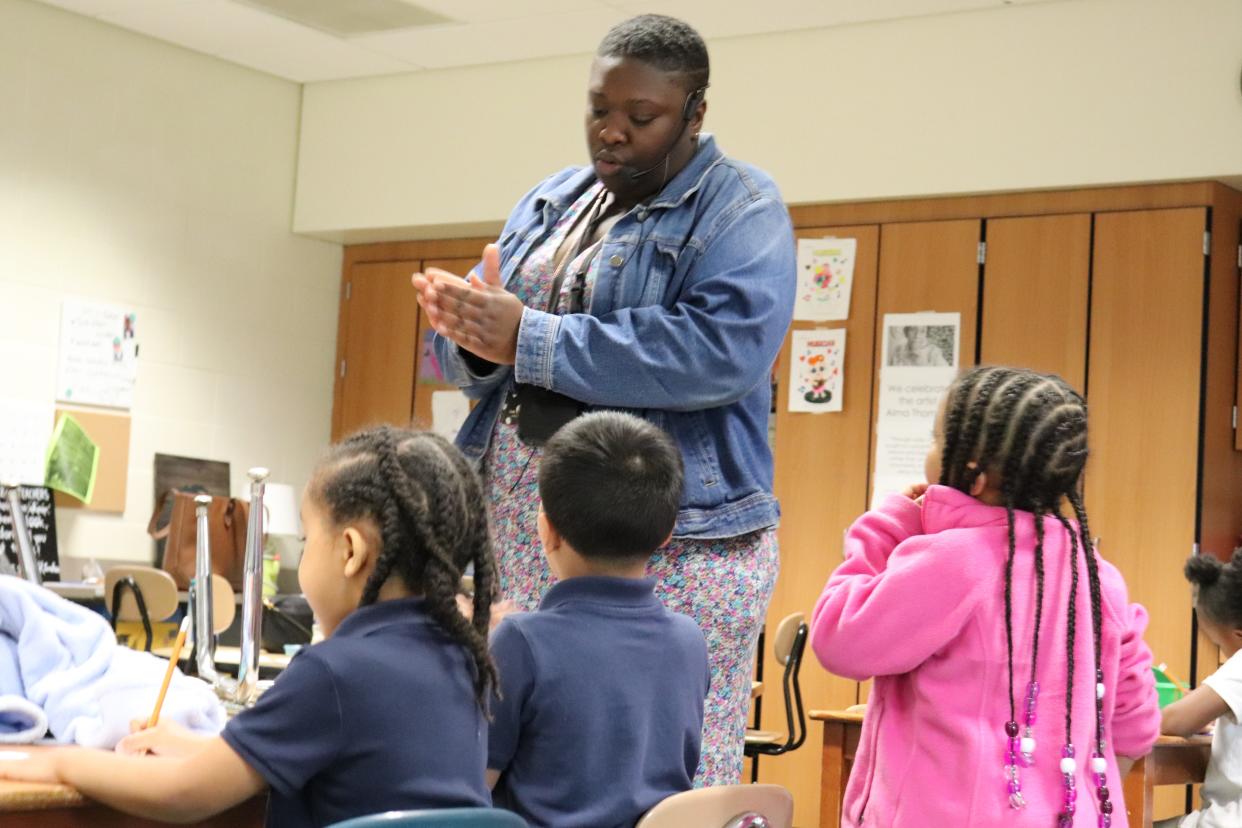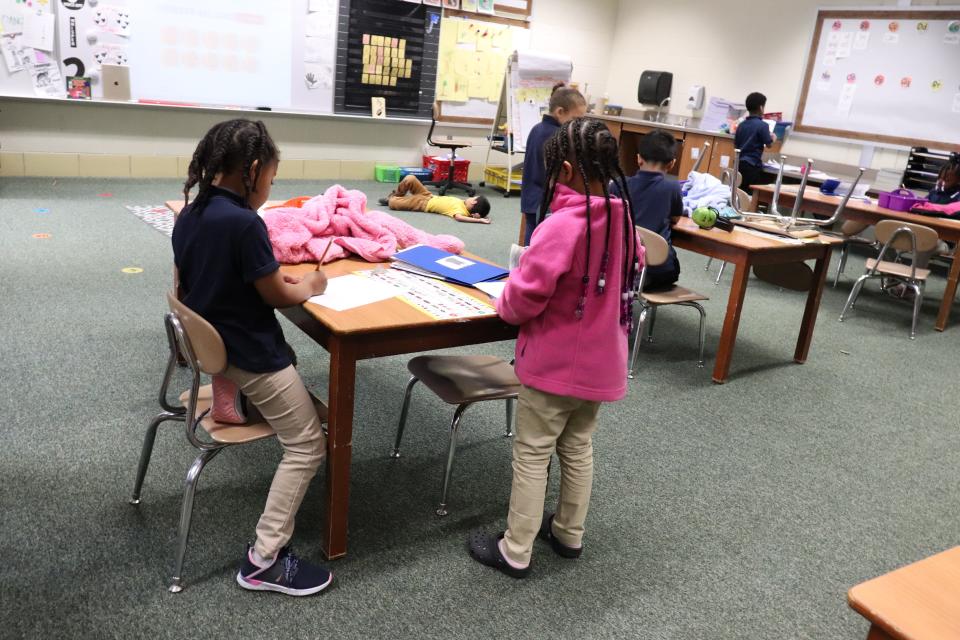South Bend educators are talking about the future of the Empowerment Zone. What comes next?

SOUTH BEND — With South Bend’s recent decision to close Warren Elementary school, talks are beginning to pick up about the future of the district’s Empowerment Zone.
Warren is one of five schools that were pulled into a subset of five schools under the threat four years ago of state takeover.
At the time, several west side schools showed evidence of dipping academic performance. Navarre Middle School by 2019 had received more than five consecutive years of failing grades in Indiana’s A-F academic accountability system.
Empowerment Zone: Educators schedule meetings to talk future of west side schools
To stave off a potential school takeover, South Bend leaders quickly put together a plan meant to intervene — providing extra financial and academic support to turn around failing grades. Navarre and four feeder elementaries were included in the plan, which was written with an initial five-year term.
With the last of those first five years set to begin in the fall, school leaders are now reflecting on an intervention period unexpectedly interrupted by the coronavirus pandemic and are beginning the conversation of what happens next.
Zone leadership says their existing contract with South Bend schools is written to auto-renew for another five years and that they deserve a chance to build on new policies enacted this school year.
But others are not so sure. Jeanette McCullough, a South Bend school board member and frequent critic of the Zone’s creation, voiced her opinion this week that the schools should be brought back into the district as they were before the intervention.
Clay, Warren to close: What comes next in South Bend school consolidation?
“The Zone should have never been started,” McCullough said during a recent board meeting. “We should have been intentionally working with our Navarre Middle School kids to make sure that they were progressing. We should be intentionally working with, and supplying the same resources that the Zone is talking about, with the other schools in this district.”
Administrators, however, say the conversation could be broader than choosing only between continuing the Zone for another five years or dissolving the arrangement altogether. Zone leaders recently outlined a series of meetings in hopes of providing greater clarity on the schools’ direction before the fall. The next meeting is at 6 p.m. Tuesday at Navarre Middle School.
“This is about the students and what we think we need to do in the best interest of our students,” Zone Chief Davion Lewis said. “They have greater needs and require additional interventions. If the body believes that a transformation zone, whether in its current iteration or a modified version of the current iteration, is the best thing to do, then that’s what we should do.”
Why create an Empowerment Zone?
The Empowerment Zone was created near the end of the 2018-19 school year as an alternative to the potential state takeover or closure of Navarre. It includes the middle school and four feeder elementaries: Coquillard, Harrison, Warren and Wilson.
Though the schools are still a part of South Bend’s public district, the Zone operates with academic independence and is managed by its own nonprofit board. Its vision follows the mindset that the needs of academically struggling students are different and what works for the larger school district may not work for students in the Zone.
The arrangement provides a high level of autonomy to Zone administrators so they can make their own decisions about curriculum, scheduling and school-level spending. Within its first four years, the Zone has split from the district in several ways, such as implementing different school hours, providing additional stipends to teachers and being early to adopt new benchmark testing to track students’ academic progress.
Empowerment Zone: What does decision to close Warren mean for the Zone?
The Zone’s structure also opened up new revenue streams, making an initial $1.2 million investment available in state intervention funds during its first year. While the Zone has a separate nonprofit entity, that independent arm makes up only 3% of the schools’ funding with other state and federal grants filtered through the South Bend district.
Some, however, have critiqued the creation of the Zone in 2019 as a process that felt disorganized and confusing.
“It was very different and there wasn’t buy-in,” Zone Board President Sam Centellas said. “It hampered our first year, and then, obviously, the pandemic happened, so we just never got out of the gate well.”
Zone leaders say conversations now are an opportunity to rethink what it means to be a Zone school and set new goals based on what’s been learned over the last four years, especially considering some of the academic benchmarks set four years ago were tied to student performance on a standardized test Indiana no longer uses.
“I’ve seen Zones work,” Lewis said. “They can work. I’ve also seen Zones not work. I would encourage the board and members of the public, as we continue this dialogue, to use this as an opportunity to get it right.”

Has the Empowerment Zone been successful?
Answering the question of whether students in the Zone are better off now than they were four years ago is difficult. State data shows, at times, a bleak picture.
The number of students absent more than 10% of the year at Navarre has more than doubled from the 2018-2019 school year to last year. Suspensions and bullying incidents are also up, and the greatest percentage of a student cohort Navarre saw passing last spring’s standardized ILEARN math or English test was 6.6%.
During those four years, however, the state introduced new and drastically different standardized testing. Then, in March 2020, the pandemic hit, disrupting the foundation the Zone had sought to establish in its first year. The new testing combined with prolonged remote learning led to dramatic declines across the state.
Still, some Zone schools struggled to show increases in the number of students passing the state test between 2020-21 and 2021-2022 — the first uninterrupted school year after the pandemic. Entire grade level cohorts at Navarre, Coquillard, Warren and Wilson saw not a single student pass certain sections of the test.
Despite that, data reported to the state shows some positives. Certified teaching staff in some Zone schools more than doubled over four years, bringing the ratio of students to certified employees into the single digits within four schools for the first time since the intervention began.
Lewis, shortly after joining the schools last August, described the Zone as “in a crisis” and quickly implemented changes seeking to improve attendance, cut down on classroom distractions and increase the time students spend learning.
Student uniforms and clear backpacks were introduced, and schools began early release Thursdays, allowing teachers more time to plan and collaborate with other educators across the Zone.
Internal data presented to the South Bend school board last week shows improvements in attendance and disciplinary referrals between 2021 and 2022. And mid-year benchmark testing shows the number of third through eighth grade students reading on grade level has more than doubled from last fall to this spring. The number of students on grade level for math has grown more than five times what it was in the fall.
“I often tell folks we’re in the pursuit of progress, not perfection,” Lewis said. “That is, in a sense, the story of the Empowerment Zone, a story of progress of time. We’re not yet where we’d like to be but have made significant progress in a variety of different areas.”
Will the Empowerment Zone continue?
With the state having pulled back its role in overseeing the Zone, what comes next will be decided at a local level. Zone leaders have expressed confidence they’ve upheld their commitments to the schools despite unforeseeable challenges early in the intervention.
Not all are convinced, however, that the Zone should be continued.
McCullough, who’s frequently shared her disapproval of the Zone throughout her two years on the South Bend board, asked why, if Zone schools are so successful, they’re not returned to the district for other schools to learn from. She questioned whether it was worth it to employ a separate administrative staff for schools still technically under the corporation’s purview, especially when the district is closing schools.
“This is an extra cost that we should not be capped with,” McCullough said. “We should bring those schools back and pay (for) those same kids and those same teachers out of the same budget.”
Mark Costello, who joined the South Bend board this winter, expressed interest in dissolving the Empowerment Zone name but keeping Lewis on working with the west side schools in some capacity. In response, Lewis said he’d like to stay in South Bend “as long as I’m invited to.”
Empowerment Zone reset: New director brings changes to west side schools
Zone leaders say they have taken steps in recent years to reduce spending and do not see themselves as competitors to the South Bend district, but rather an offering in its portfolio.
Lewis outlined a series of next steps in the conversation beginning with a public information session Tuesday at Navarre and finishing with a series of board approvals in June.
At least one member of the South Bend school board, however, shared a light skepticism over the timeline, suggesting it may be too aggressive for the pace business typically moves at within the district.
Lewis says he sees no indication that his own board would like to end the Zone. Though, Centellas, the Zone board president, said he’d like to take a conservative approach in discussing any extensions.
“Whether we extend for three or five years, it could be extended again,” Centellas said. “People think everything’s done, but it’s not. A good board is continuing to look at things.”
What comes next in deciding the Zone's future?
This is the timeline Empowerment Zone school leaders have proposed for deciding what's next:
May 9: At 6 p.m., the Zone will have a public forum at Navarre about its future.
May 15: The Zone board will meet with the South Bend school board in executive session.
May 16: The Zone Board will meet in public to discuss its future.
June 21: The South Bend school board is expected to take action on the Zone's future.
June 26: The Zone board will vote to ratify action taken by the district board.
Email South Bend Tribune education reporter Carley Lanich at clanich@gannett.com. Follow her on Twitter: @carleylanich.
This article originally appeared on South Bend Tribune: With a year left, what's next for South Bend Empowerment Zone schools?

